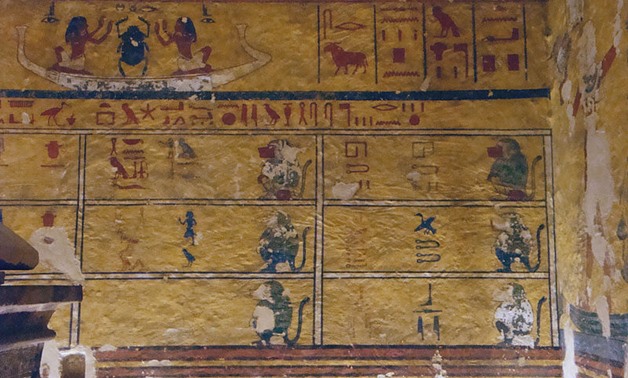
A Painting for King Ay - Photo Courtesy of Flicker
CAIRO - 22 January 2018: Several secrets around Ancient Egypt and its rulers have not yet been revealed; the magical Egyptian deserts still carry a lot underneath their sands.
Ministry of Antiquities announced that famous Egyptologist, author and former Minister of Antiquties Zahi Hawas will lead an archaeological mission to begin new excavation works at Valley of the Monkeys, located at Valley of the Kings, according to a statement released on the Ministry of Antiquities official Facebook page.
 King Ay while opening the mouth ceremony on Tutankhamun - Photo Courtesy of Wikipedia
King Ay while opening the mouth ceremony on Tutankhamun - Photo Courtesy of Wikipedia
Taking place near King Ay's tomb, the forthcoming excavation works are mainly trying to unearth a tomb that was found by Radar Scans.
According to the Daily Mail website, Hawas’ spokesman stated on Hawas’ official website, “The radar scans in the area detected the presence of a possible entrance to a tomb at a depth of five meters (16 feet).”
The tomb may belong to one of Tutankhamun's family members, as Queen Ankhesenamun's tomb is still hidden.
 A burial chamber of King Ay's tomb - Photo Courtesy of Wikipedia
A burial chamber of King Ay's tomb - Photo Courtesy of Wikipedia
So, many questions come to the readers' minds, who is King Ay? Why will the excavation works take place near his tomb?
King Ay was the one who succeeded King Tutankhamun; in addition, he got married to Tutankhamun's widow Queen Ankhesenamun.
King Ay got married to king Tutankhamun's widow to give himself the legitimacy to reach the throne, according to researcher and author Ismail Hamid.
Professor Percy Newberry explained that he recorded a ring he found in Cairo that carries the names of King Ay and Queen Ankhesenamun.
 Ay receiving the Gold of Honor – Photo Courtesy of Wikipedia
Ay receiving the Gold of Honor – Photo Courtesy of Wikipedia
It is believed that King Ay reigned over Egypt for only a few years from 1323 B.C. to 1319 B.C., according to Encyclopedia Britannica.
King Ay was a member of King Akhenaten's court; he was even titled "The God Father" of the royal court.
During King Tutankhamun's reign, Ay was elder statesman of the young king; also a number of sources claimed that Ay was the main ruler, and he set the guiding lines, according to archaeologist Enas el-Shafie.
She also added in her interview with "Bain El-Sotor" (Between the Lines) program aired on On Live channel that King Ay's wife cooperated with the popular commander in chief of the army Horemheb to reach the throne.



Comments
Leave a Comment